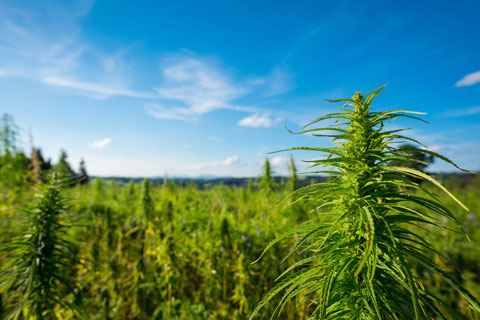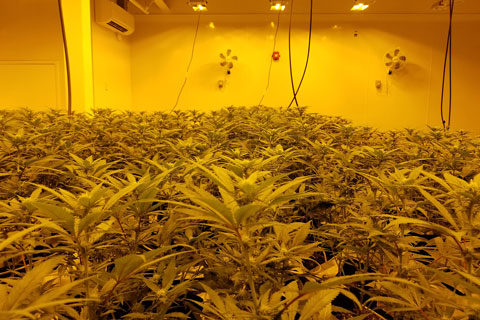2/1/2023
Optimal Environment for Cannabis
Dr. Brian Corr

In our final excerpt from the new cannabis chapter in the 19th edition of the Ball RedBook written by Dr. Brian Corr, he addresses the cultivation environment, including light, ventilation, temperature and air.
There’s one thing all cannabis growers agree on: cannabis grows best with as much light as you can give it. Research, as well as observations of growers, has shown that cannabis growth increases as the amount of light received increases (assuming no other limiting factors). Studies have shown increased growth up to at least 1,500 µmol/sq. m/sec photosynthetically active radiation (PAR). It’s likely that optimal light intensity varies depending on cultivar.
Pictured: Cannabis grown in fields for production of fiber or seed will produce pollen during the summer, which can travel in the air hundreds of miles and potentially get into greenhouses producing medicinal or recreational cannabis. Seed set can occur, reducing the value of the crop.
If cannabis is grown at 1,500 µmol m-2 s-1 for 12 hours per day, this results in a daily light integral (DLI) of almost 65 mol m². This is more light than most locations on earth receive in a day. Light levels this high are impractical for most growers. Nevertheless, it illustrates that cannabis can benefit from large amounts of light.
During the vegetative phase, the light period can be as long as 24 hours per day to increase the DLI, although this is seldom practiced. However, during the flowering phase, the daylength is typically 12 hours, which limits the DLI. Cannabis should be grown with as high a DLI as practical during the flowering phase, with a minimum of 30 mol m-2 a good target. To reach a DLI of 30 mol m-2 requires an average of approximately 700 µmol
m-2 s-1 over a 12-hour photoperiod.
Increased light results in more compact plants, including the inflorescence (bud), which is generally considered to be desirable for cannabis to be sold as dried flower. Higher light intensities have resulted in higher cannabinoid percentage in some studies, but not others. Regardless, total cannabinoid yield is increased by the greater yield in dry weight even if the percent concentration isn’t changed.
The spectrum of light can influence the morphology of the plant. For example, increased blue light results in a more compact plant, although increased blue light may result in an overall reduction in yield. When sole-source lighting has been used in the past, metal halide lamps were often used during vegetative growth, with high pressure sodium (HPS) lamps used during flowering. Metal halide has a higher percentage of blue light in comparison to HPS, leading to more compact growth in the vegetative phase.
Prices of LED lamps have become more competitive in the last several years. These lamps tend to be more energy efficient than HPS and can be manufactured to produce virtually any spectrum of light. It should be noted, however, that some spectra are less energy efficient than others. The criteria for choosing an LED lamp should prioritize the energy efficiency and photon efficiency.
Subcanopy lighting (or intercanopy lighting) is the practice of installing strips of lights (typically LED) at the base of the plant canopy or midway in the canopy. This practice has been shown to increase yield, although whether that was by the placement of the light or simply by increasing total light for photosynthesis is unclear.
Temperature and ventilation
Although cannabis will survive temperatures between about 30 and 120F (-1 to 49C), optimal growth occurs in a narrower range. Growth effectively stops below approximately 42F (6C). Growth increases as temperature increases up to at least 84F (29C), although there’s evidence of variation in optimum temperature between cultivars originating from different environments.
For the comfort of employees, as well as to minimize the cost of heating, cannabis is typically produced with a target day temperature range of 77 to 82F (25 to 28C). Some greenhouse growers in cooler areas drop night temperatures to around 68F (20C) for energy savings. Some growers reduce temperature in the last couple of weeks of production to induce purple color, which is appreciated by some consumers. Color development is largely controlled by genetics, but cooler temperatures enhance the color.
The average daily temperature controls the speed of growth, but the day and night temperature setpoints can also influence growth. Anecdotal evidence suggests day/night temperature differential (DIF) can influence stem elongation of cannabis as it does other species. If the temperatures for the first few hours of the light period are lower than the night temperatures, stem elongation is reduced. Stem elongation is enhanced by warmer temperatures at the beginning of the light period. Lowering the temperature during the light period can be expensive in an indoor growing facility, but often can be done in a greenhouse by drawing in cooler air at the beginning of the light period.
It’s important to remember that if a photon flux of 1,000 µmol m-2 s-1 is provided by HPS lamps, the lights can increase leaf temperature up to 4 degrees F (2 degrees C) and the temperature of the dense flower buds up to 9 degrees F (5 degrees C) compared to the same photon flux from LED lamps. It’s the temperature of the plant tissues that matters, not the temperature of the air.
Problems can arise when temperatures are above or below the recommended temperature. An unacclimated cannabis plant may be damaged by cold, but a well-acclimated plant adapted in the field by gradually declining temperatures can survive temperatures below freezing. In the same way, acclimated plants can tolerate temperatures up to about 120F (49C), but temperatures above about 84F (29C) slow growth.
Air: Carbon dioxide enrichment
An often-overlooked aspect to optimizing plant growth is the air around the plants. Cannabis benefits from carbon dioxide enrichment of the air. This is practical year-round in warehouse growing conditions and in a greenhouse when air exchange is limited. However, in the field or when greenhouses are being ventilated, carbon dioxide enrichment isn’t practical.
Increasing carbon dioxide levels to 1,000 to 1,500 ppm during daylight hours enhances cannabis growth. There are three common ways to increase carbon dioxide concentration in the air:
● Generate carbon dioxide by burning natural gas or propane. This is acceptable in a greenhouse, but not ideal. When these gasses are burned, they generate not only carbon dioxide, but also water, raising humidity.
● Capturing waste carbon dioxide from exhaust gases from a boiler. This is a practical and efficient way to increase carbon dioxide levels, but requires specific boilers, which may not be economical for smaller facilities.
● Purchase liquified carbon dioxide. This is typically the most expensive way to supplement carbon dioxide, but is reasonably easy to set up in both large and small facilities. A compressed gas supplier can provide a refillable tank, and the piping and regulators to distribute the gas.
Carbon dioxide is more dense than air, so it’ll tend to settle to the lowest point of the greenhouse. Circulating fans should be used to mix the carbon dioxide in the growing area.
The United States Occupational Health and Safety Administration (OSHA) has set standards for safe levels of carbon dioxide in the workplace. Short-term exposure is limited to 30,000 ppm and no more than 5,000 ppm exposure on average over an eight-hour shift. A carbon dioxide sensor connected to an alarm set to alert employees if the carbon dioxide level exceeds the set point is a good safety feature and may be required by some codes.
Air: Relative humidity
A second characteristic of air that must be managed is relative humidity. High relative humidity can favor disease development and reduce uptake of nutrients such as calcium. Most cannabis growers strive for relative humidity between 50% and 70% during the mother stock, vegetative and flowering stages of the crop. Although this is the target, it’s often difficult to achieve, particularly in greenhouses, and certainly outdoors.
Managing humidity at night is especially important. During the day, leaf temperature is typically as warm or usually warmer than the air. At night, however, this can be reversed. If the leaf temperature drops below the air temperature and the relative humidity is high, condensation can occur on the leaves. This leaf moisture increases the risk of foliar disease.
 Pictured: Increased light results in more compact plants, including the inflorescence (bud), which is generally considered to be desirable for cannabis to be sold as dried flower.
Pictured: Increased light results in more compact plants, including the inflorescence (bud), which is generally considered to be desirable for cannabis to be sold as dried flower.
For enclosed growing spaces, dehumidification equipment can effectively control humidity. In greenhouses, the first choice to reduce humidity is to ventilate by pulling outside air into the greenhouse. This works so long as the outside air contains less moisture than the air inside the greenhouse. Since cold air cannot contain as much water as warm air, even if the relative humidity is high outside, so long as the air is colder outside, the relative humidity in the greenhouse can be reduced by replacing the air in the greenhouse with cooler outside air and heating it.
It’s the humidity and carbon dioxide level at the surface of the leaf or flower that matters, not at a sensor positioned well above the crop. Air movement through and around the crop canopy will reduce the boundary layer of stagnant air at the surface of the leaf.
Air: Pollen drift
Another aspect of air management unique to cannabis is control of pollen drift. Cannabis grown in fields for production of fiber or seed will produce pollen during the summer. Cannabis pollen can travel in the air for hundreds of miles. If this pollen drifts into a greenhouse producing medicinal or recreational cannabis, seed set can occur, reducing the value of the crop.
Production in completely closed warehouses or greenhouses modified to have reduced air exchanges can minimize pollen entry by filtering incoming air. This isn’t practical in traditional greenhouses and is impossible in field production.
Other than locating somewhere away from fields of seed or fiber cannabis, there’s little that can be done for field or traditional greenhouse production. However, field cannabis only produces pollen for a short time and that pollen needs to remain viable to cause seed set. At high humidity, cannabis pollen dies quickly.
In one study, about half of cannabis pollen survived for 24 hours at 15% relative humidity, but only about 20% survived 24 hours at 51% relative humidity. After 72 hours, all the pollen was dead except the pollen at 15% relative humidity, and even with that exceedingly dry air only about 10% of the pollen was alive. Much of the U.S. has high humidity when field hemp is producing pollen, which will minimize how long pollen survives.